From Stage to Screen: Mapping the Theatrical Roots of Britain’s Biggest Screen Stars
A new dataset analysing the careers of more than 100 British actors and actresses who have won major screen awards over the last 25 years, including BAFTAs, Academy Awards (Oscars), Emmys, Golden Globes, SAG Awards and Cannes recognition, reveals a consistent but often overlooked pattern: three fifths (60%) of them started in theatre.
This data-led project examines the early careers of the UK’s most acclaimed screen talent, uncovering common threads in their origins, including where they were born, whether they trained formally, how they entered the industry, and whether they remain connected to the stage.

By tracing the journeys of these actors across generations, regions, and institutions, the report reveals the ongoing influence of the UK’s theatrical ecosystem, from drama schools and fringe venues to Olivier-winning performances, on global screen success. It also highlights shifts in training routes, regional hotspots for talent, and evolving careers into film and television.
At a time when arts education faces cuts and the role of theatre in the screen industry is often undervalued, these findings offer timely cultural insight, and a reminder that stage and screen remain deeply connected.
Methodology
This analysis draws on an original dataset of more than 100 British actors and actresses who have won at least one major screen award between 2000 and 2025 (BAFTA, Academy Awards, Emmys, Golden Globes, SAG, or Cannes). We also record stage awards (Olivier, Evening Standard, Critics’ Circle) to map the stage–screen overlap. For each performer, we tracked birthplace, drama school training, early career routes, theatre awards, and current stage involvement.
The data was then examined for generational, geographic, and institutional patterns, revealing how the UK’s theatre culture continues to underpin global screen success.
Key Findings at a Glance
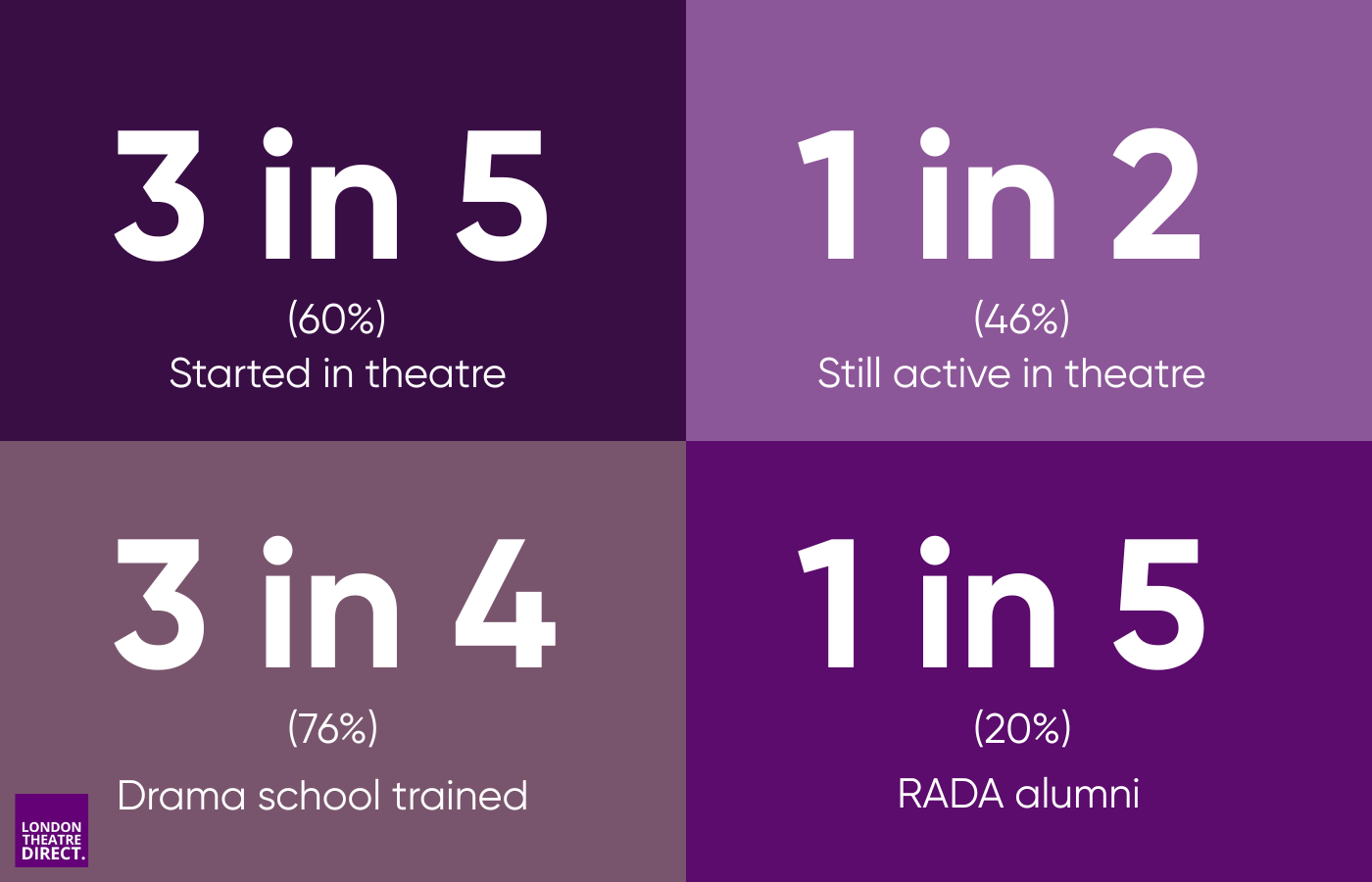
- Three in five (60%) award-winning British screen actors began their careers in theatre.
- Nearly one in two (46%) are still active on stage today.
- Three in four (76%) received formal drama school training, while one in four (24%) bypassed it entirely.
- One in five (20%) trained at RADA, making it the single most common institution among award winners.
What Defines Success on Screen?
When we talk about “screen success,” the conversation can feel slippery. For some, it’s the glitter of an Oscar. For others, it’s the sustained excellence of a BAFTA-winning career or the recognition of peers at the SAG Awards. In this campaign, we’ve chosen to anchor “success” in the most tangible of ways: awards.
Our dataset tracks 114 British actors and actresses with major screen awards between 2000 and 2025, including BAFTAs, Academy Awards (Oscars), Emmys, Golden Globes, SAG Awards and Cannes recognition, and then looks across their broader award portfolios. By that measure, three in four (75%) in our cohort are BAFTA winners, while about one in six (16%) have lifted an Oscar. A smaller but elite group, one in seven (14%), have managed both, placing them among the most decorated screen talents of the last quarter century.
But the picture of success doesn’t stop there. Many of these actors also hold trophies from other corners of the industry: one in three (32%) have an Emmy on the shelf, another one in three (31%) a Golden Globe, and about one in four (23%) a SAG Award. Cannes appearances are rarer, with just a handful of British-born winners, and Grammys rarer still.
Across the group, the median tally is 19 wins and 40 nominations suggesting that half of these performers have been recognised at least that many times across the major award circuits. At the top end, more than one in four (28%) can be described as highly decorated, with 30 or more career wins.
What’s striking is how often the story of screen success intersects with the story of the stage. About one in five (21%) of these performers have theatre accolades recorded alongside their screen triumphs, Olivier Awards, Evening Standard Theatre Awards, or Critics’ Circle Theatre Awards. And one in six (16%) manage the rare double: decorated both on stage and on screen.
![]()
But trophies only tell part of the story. To understand what shaped these careers, we need to trace their roots back to the stage.
From Stage to Screen: Career Pathways
If awards define success, then pathways explain it. The question at the heart of this campaign is: how did Britain’s most decorated screen actors get there?
The data shows that theatre is the launchpad for a majority of winners. Of the 114 actors in our dataset, three in five (60%) began their careers on stage. This ranges from Olivier-winning West End shows debuts to regional rep companies and fringe performances, the stepping stones that sharpened their craft before film and television came calling.
What’s more, theatre is not just a beginning, but often a constant companion. Nearly one in two (46%) of Britain’s major-award-winning actors are still active in theatre today. From Mark Rylance’s ongoing Shakespearean work to Jodie Comer’s award-winning Prima Facie performance, the pull of the stage remains strong even for those who have scaled Hollywood heights.
Theatre-to-screen is by far the most common route, but the flow does move both ways. Actors such as Benedict Cumberbatch and Olivia Colman started in theatre, transitioned into global stardom via TV and film, only to return to the stage later in their careers. The data shows a dynamic interplay between mediums, where skills honed on stage fuel screen success — and screen recognition, in turn, elevates stage productions when stars return.
This duality is central to Britain’s cultural power. The actors who dominate major film awards are not just film stars: they are, fundamentally, theatre actors whose craft has been forged in live performance.
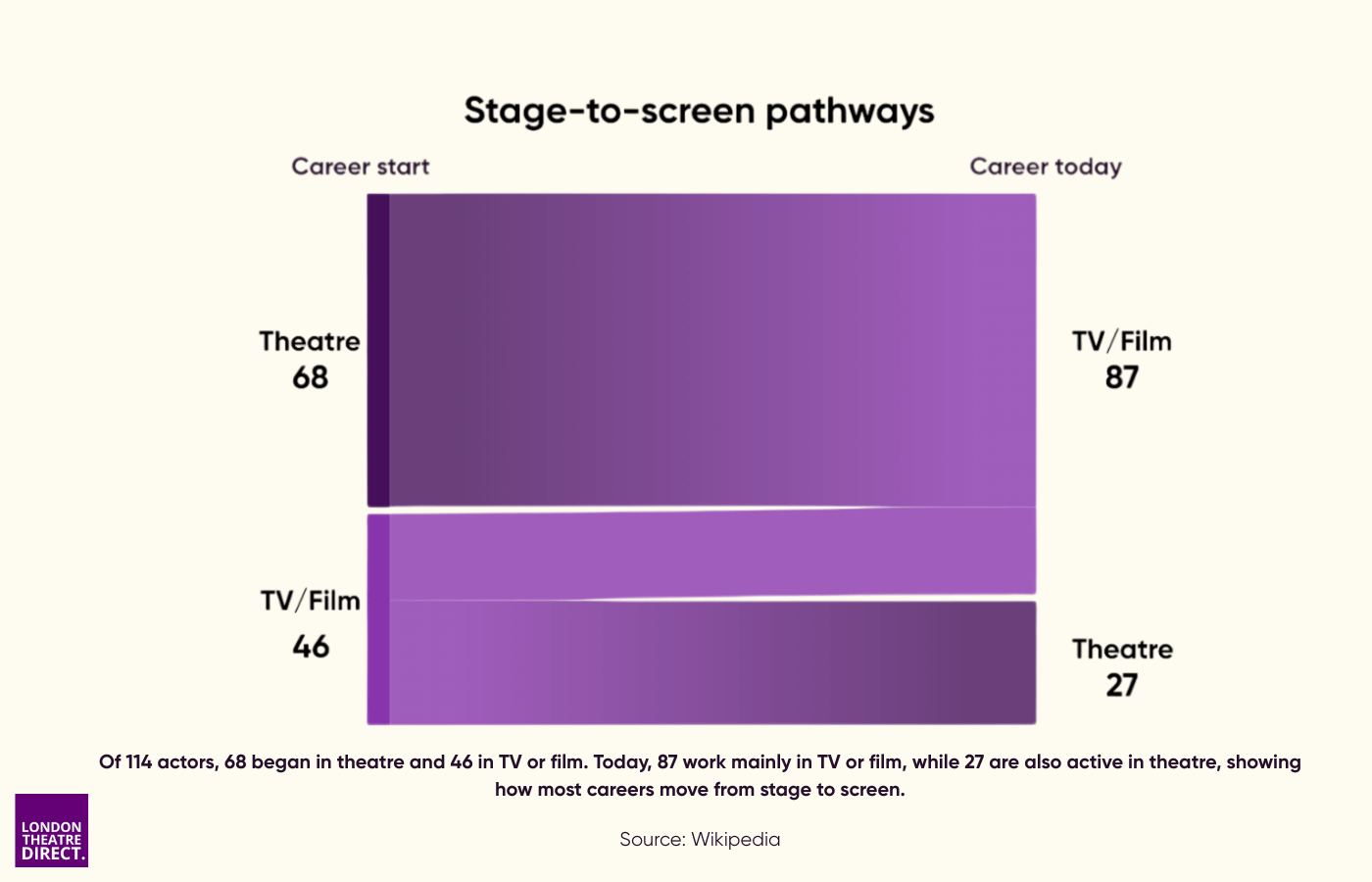
Drama School Power: Training the Stars
Behind many of Britain’s most celebrated actors lies another institution: the drama school. Our dataset reveals that three in four award-winning performers attended formal training, while one in four bypassed drama school altogether, proving there is no single route to success:
- Three in four (76%) of award winners in our dataset attended drama school, while one in four (24%) did not.
- Among trained actors, two in three (68%) started in theatre; among untrained actors, it’s one in three (33%).
- The connection persists today: one in two trained actors (52%) are still active in theatre, compared with one in four untrained actors (26%).
Within that trained majority, certain schools
dominate. One in five (20%) of the actors trained
at RADA (Royal Academy of Dramatic Art), making it the
single most common alma mater among awards winners of
the last 25 years.
Close behind are LAMDA, Guildhall
School of Music & Drama, and Central School of
Speech and Drama, each contributing multiple
award-winning alumni, with many from Guildhall
also having performed in several well-known West
End musicals.
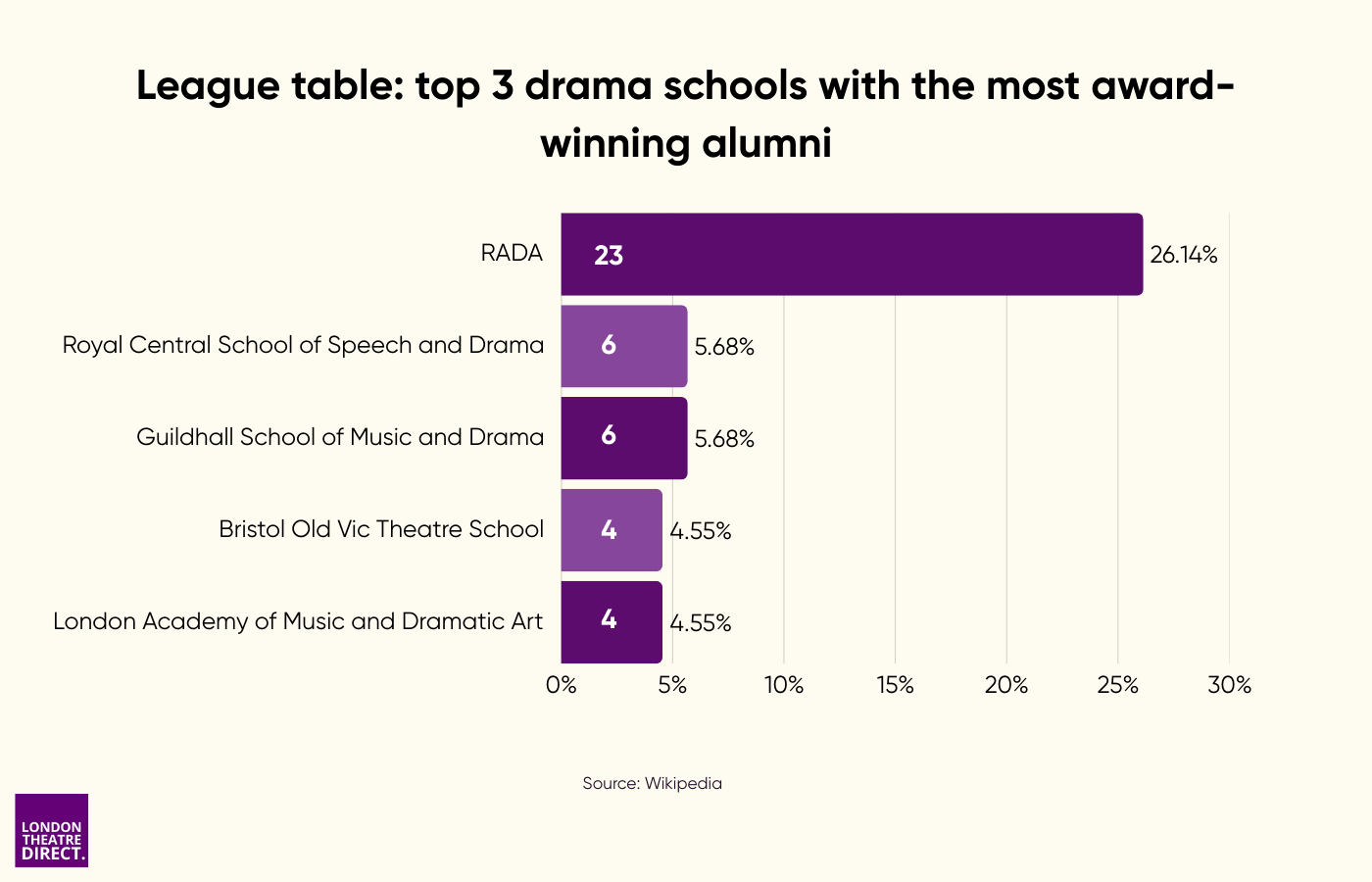
Beyond the Big Four: Surprising Training Routes
While RADA, LAMDA, Guildhall and Central dominate the league table, the data also throws up some striking outliers that speak to the breadth of Britain’s training landscape. The Identity School of Acting, founded in 2003 as a part-time evening school, has already produced three award-winning alumni in this cohort, a remarkable feat for a relatively new institution that has widened access and helped diversify routes into the profession. At the other end of the spectrum, Drama Centre London, which closed its doors in 2022, still places four alumni among awards winners of the past quarter-century, a reminder of its legacy influence despite its absence today.
Grassroots and alternative training models also make their mark. The Anna Scher Theatre in Islington, long celebrated for its community ethos, claims two alumni, while The Television Workshop contributes one. Together, they show how Britain’s non-conservatoire pipeline continues to funnel raw talent into the highest levels of the screen industry. And training isn’t just a London story: the Royal Conservatoire of Scotland places three alumni, underscoring the strength of regional pipelines. Finally, the data even hints at the role of international influences, with an alum of École Jacques Lecoq in Paris making the list, a reminder that movement-led and physical theatre traditions can play a vital role in shaping Britain’s screen icons.
Training changes pathways, not necessarily outcomes
On career-wide award volume, medians are comparable (and in this dataset, untrained actors skew slightly higher — likely reflecting a few outliers):
- Trained: median
19 wins
and 39 nominations
- Untrained: median
22 wins
and 46 nominations
The bigger differences are in how success is reached: trained actors are twice as likely to both start in theatre and remain active there today.
Generational shifts in training and theatre attachment
Training remains prevalent across generations, but younger winners are less likely to be currently active on stage , a sign of changing industry demands (and perhaps the gravitational pull of global TV/streaming).
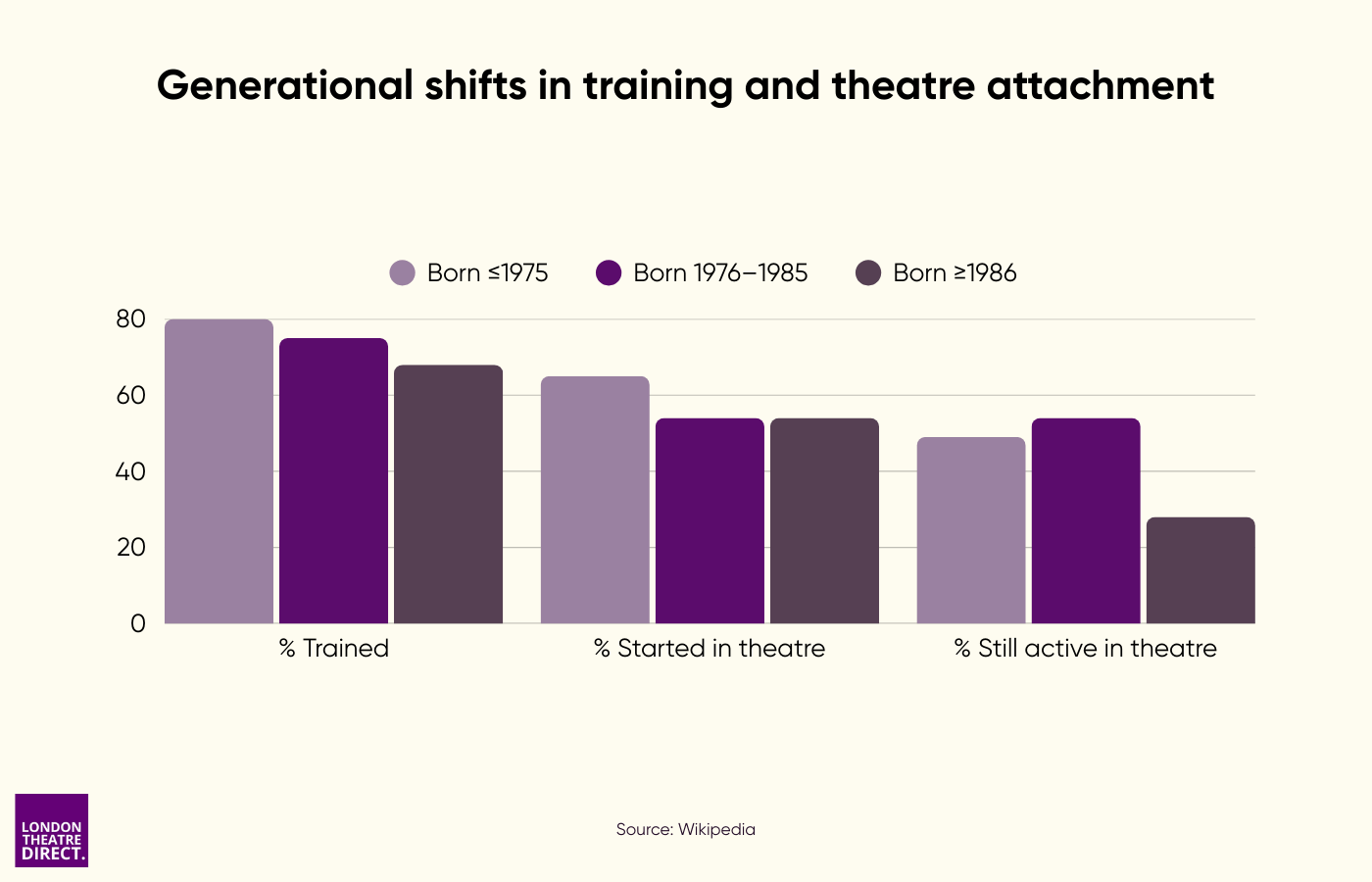
Among actors born before 1975, formal drama training was almost universal: four in five (80%) are school-trained, and two in three (65%) began their careers in theatre. Crucially, one in two (49%) from this group are still active on stage today, reflecting a career-long attachment to theatre.
By contrast, actors born between 1976 and 1985 still show high levels of training (three in four, 75%) but are less anchored to the stage: just over one in two (54%) started in theatre, and a similar share remain active there now.
The most striking change appears among the youngest group, born after 1986. While training remains prevalent (two in three, 68%), only one in two (52%) started in theatre, and just one in three (28%) are still active there today. For Britain’s newest generation of award winners, theatre is less often a career-long destination and more often a launchpad to screen.
These figures suggest a subtle but important generational shift. For older actors, theatre was both training ground and professional home. For younger stars, it increasingly serves as an early showcase before film and high-end television take over. In the streaming era, global demand for British talent is higher than ever, but the data shows that the enduring pipeline from stage to screen is changing shape.
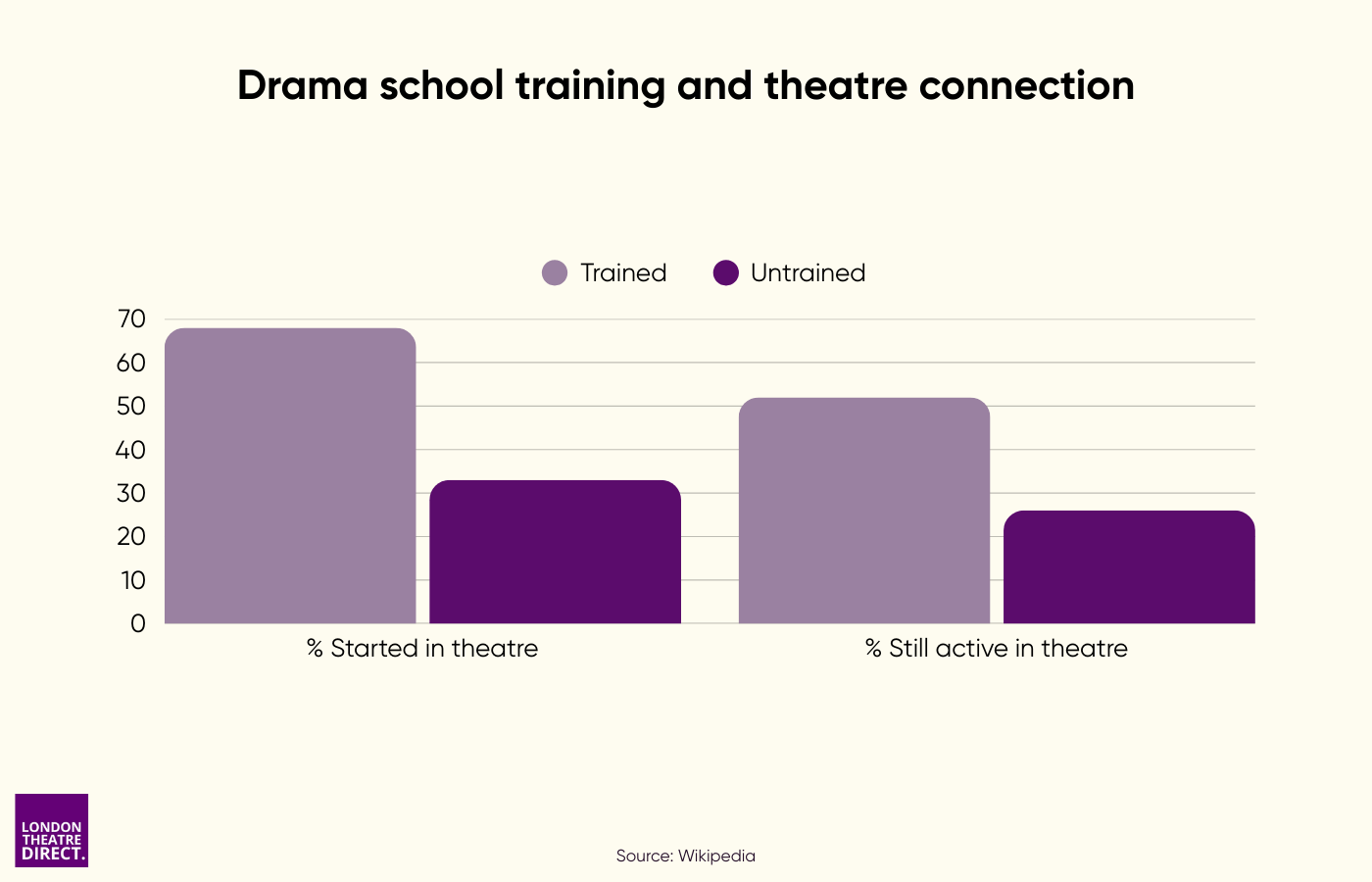
The Cities and Towns That Shape Screen Icons
Britain’s biggest screen stars are born across a surprisingly wide map, with clear clusters, but the full picture is more varied than a single postcode story.
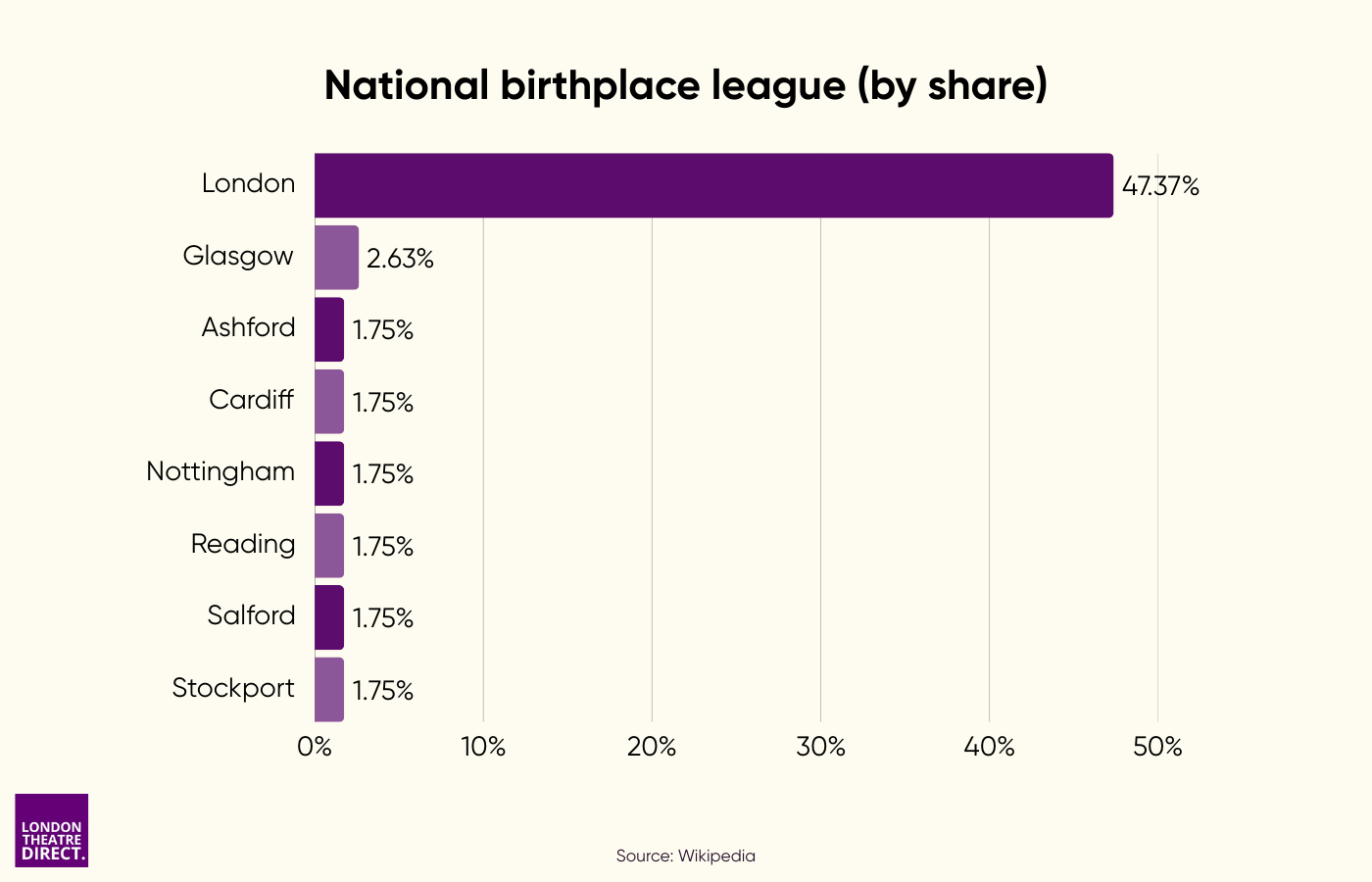
Nearly one in two (47%) of all birthplaces are in London and its boroughs, while just over one in two (53%) are outside the capital. The real headline, though, is the long tail: our dataset spans 87 distinct birthplaces, and two in three (66%) of all actors appear as the only award winner from their city or town. In other words, global talent emerges from everywhere.
Hammersmith named the UK’s top birthplace for BAFTA/Oscar winners
London boroughs account for 53 winners’ birthplaces overall, led by Hammersmith and Westminster.
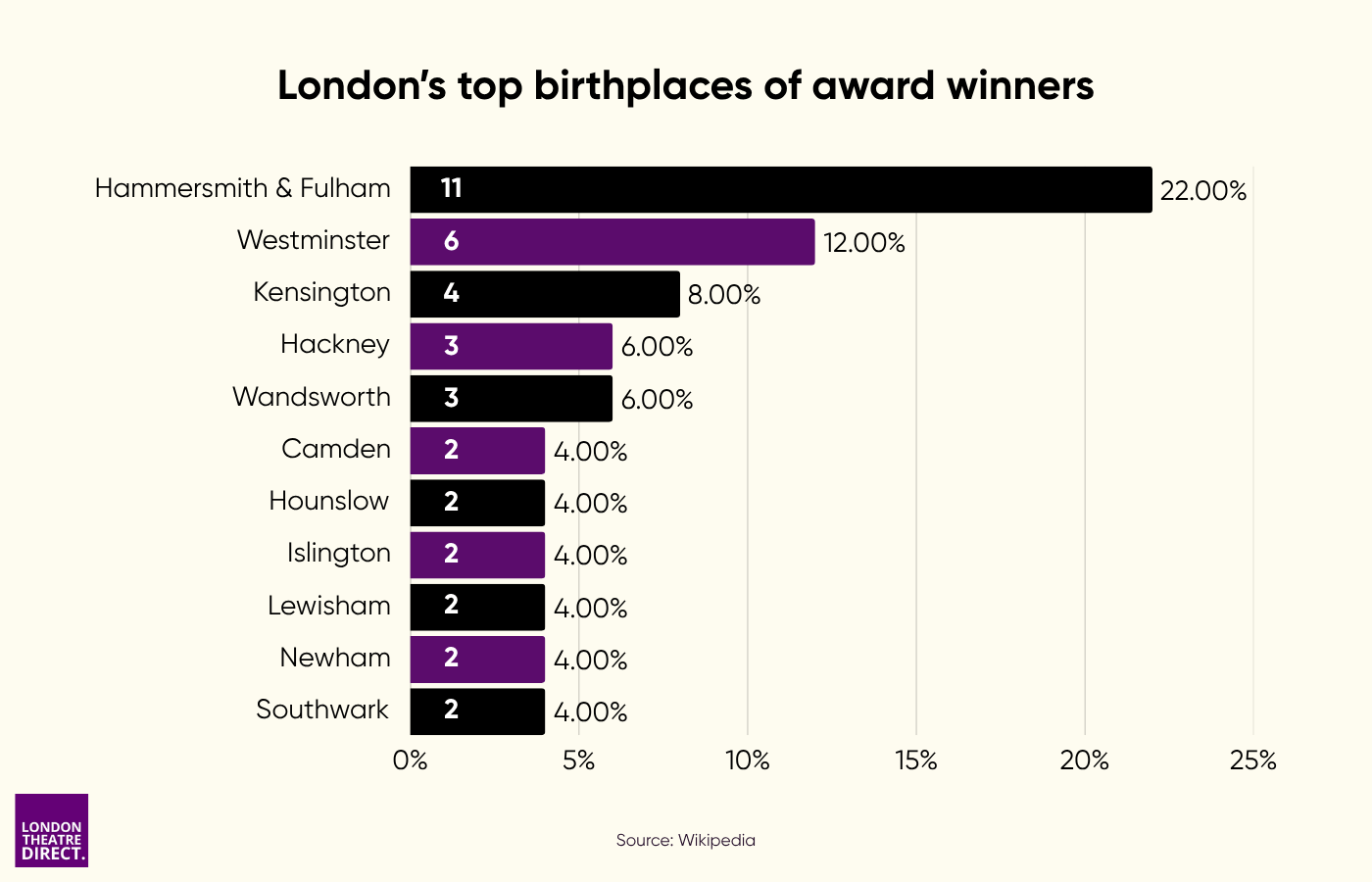
Notable names:
- Hammersmith: Helen Mirren, Tom Hardy, Will Poulter, Juno Temple, Lashana Lynch
- Westminster: Eddie Redmayne, Rachel Weisz, Thandiwe Newton, Tom Hiddleston
- Hackney: Idris Elba, Bukky Bakray, Adam Deacon
- Kensington: Daniel Day-Lewis, Stephen Dillane
Greater Manchester contributes 4 winners’ birthplaces — led by Salford and Stockport.
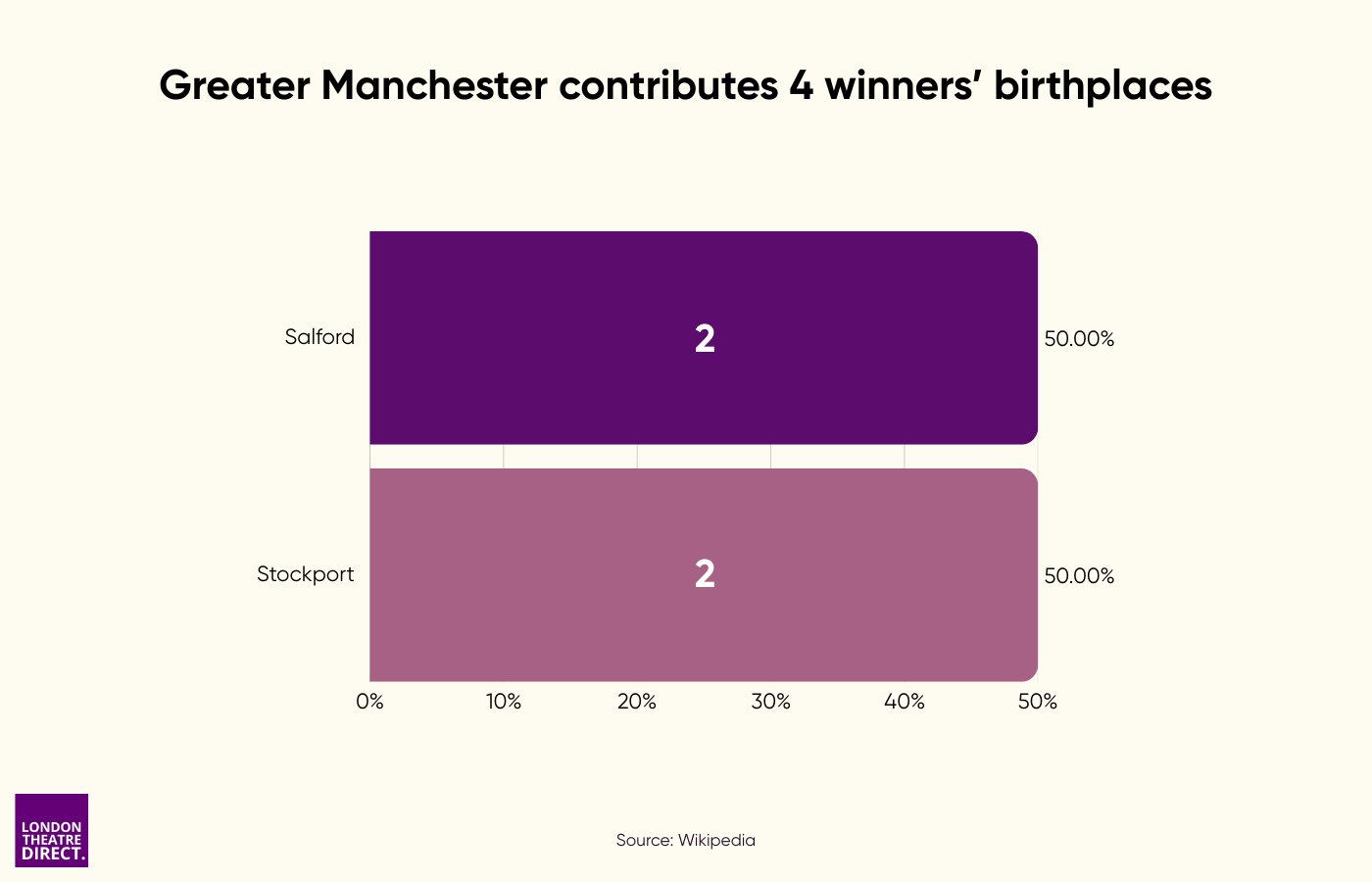
Notable names:
- Salford: Albert Finney, Christopher Eccleston
- Stockport: Claire Foy, Aimee Lou Wood
Scotland’s share is led by Glasgow with 3 winners’ birthplaces
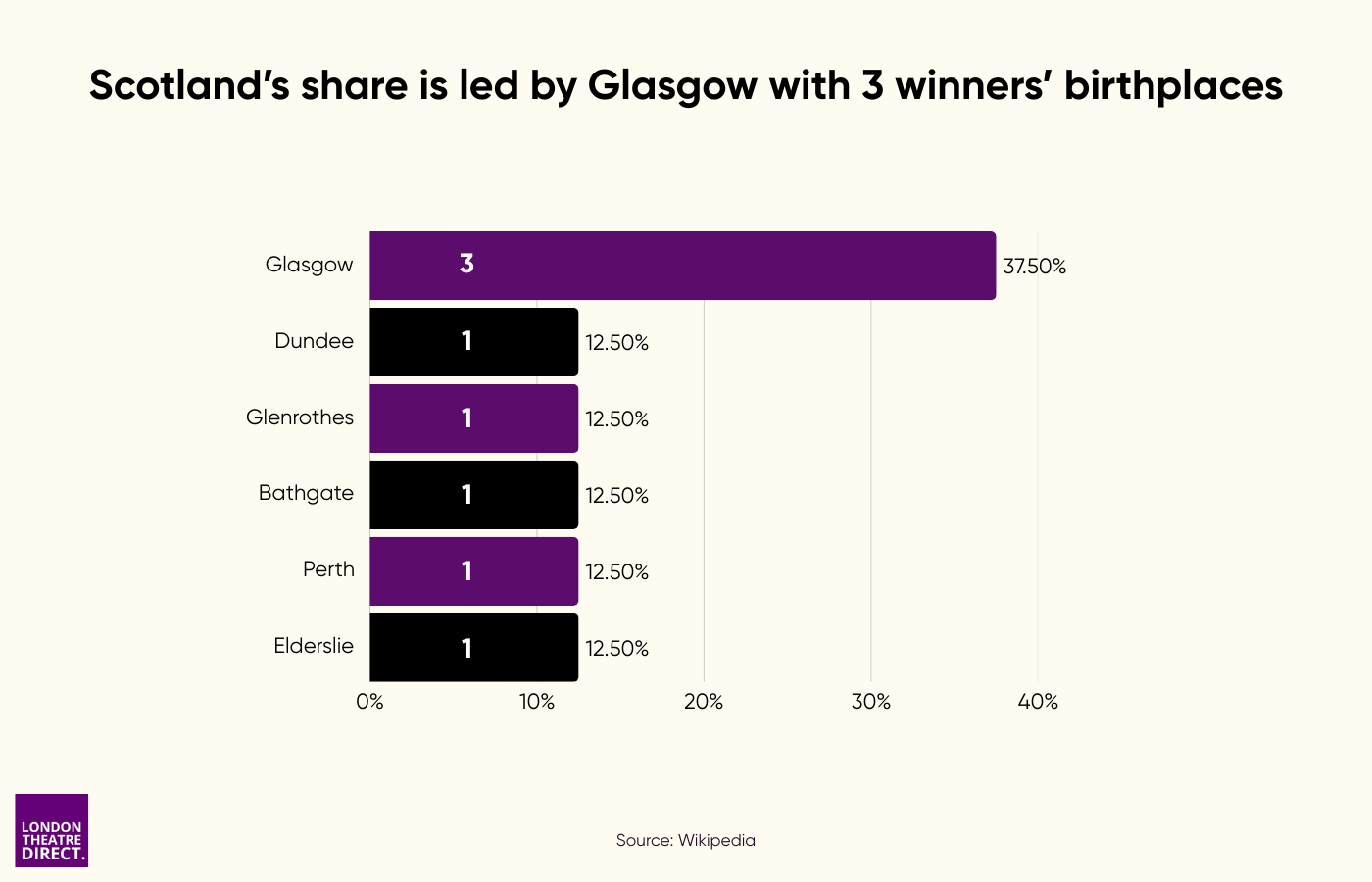
Notable names:
- Glasgow: James McAvoy, Peter Capaldi, Kelly Macdonald
- Dundee: Brian Cox
Cardiff leads Wales in birthplaces with 2 award winners
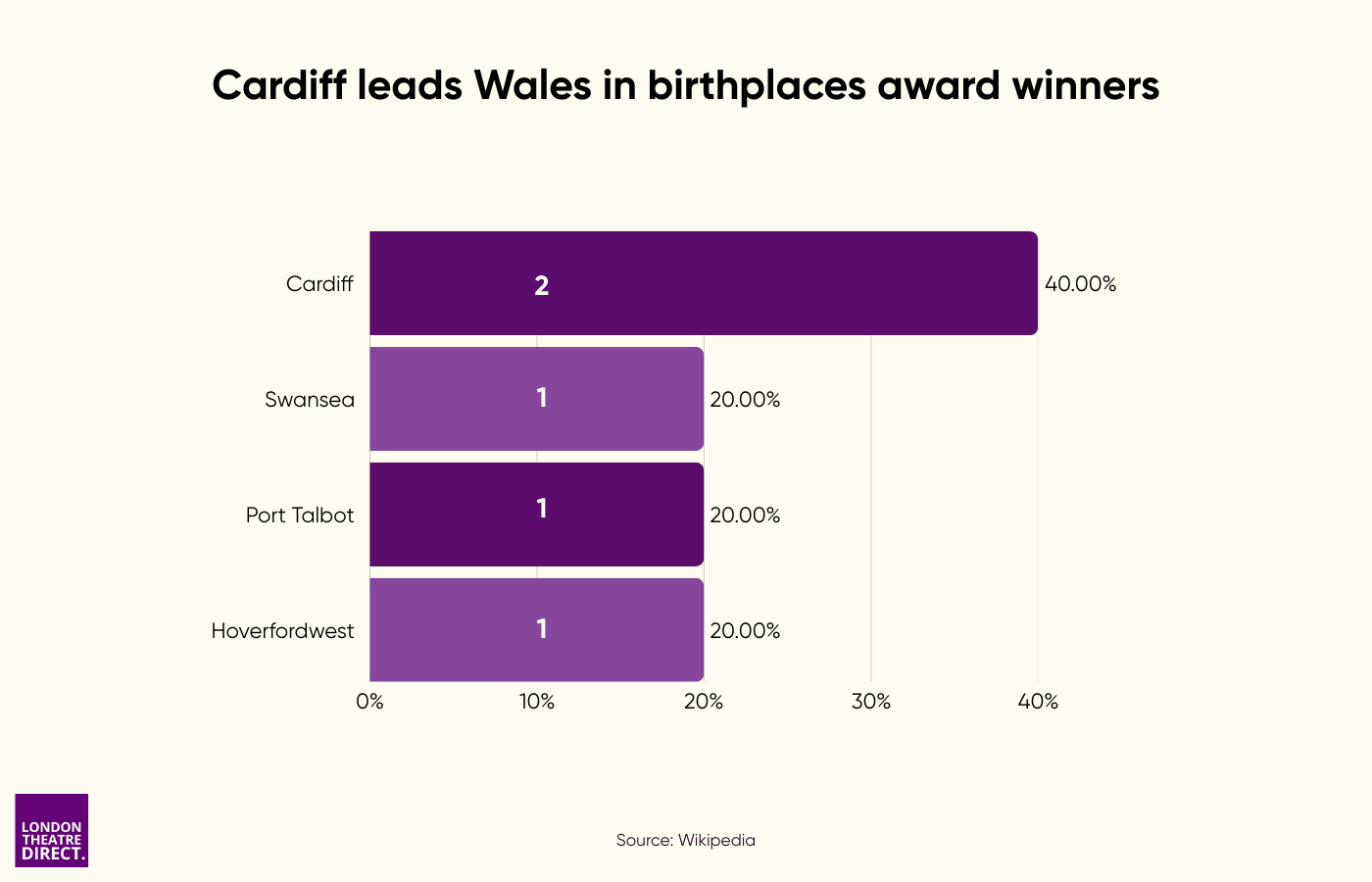
Notable names:
- Cardiff: Matthew Rhys, Rakie Ayola
- Swansea: Catherine Zeta-Jones
Conclusion
Across more than 100 award-winning British actors, the pattern is consistent: three in five (60%) began in theatre and nearly one in two (46%) are still active on stage. Most trained formally, three in four (76%), with one in five (20%) passing through RADA, yet the pipeline is broader than any one school, and the map is far from London-only: the cohort spans 87 distinct birthplaces, with two in three (66%) the only winner from their city or town. Taken together, the data suggests something simple and durable: the stage remains the foundation of British screen excellence, even as pathways diversify in the streaming era. And if that foundation matters, the most direct way to sustain it is to experience it, see the craft that shapes screen success live ; explore what’s on now with London Theatre Direct and catch a favourite returning to the stage or the next name on the rise.
Appendix: Full Methodology
Dataset scope
- Actors and actresses born in the UK
- Winners of major screen awards over the last 25 years (2000-2025), including BAFTAs, Academy Awards (Oscars), Emmys, Golden Globes, SAG Awards and Cannes recognition Total sample size: 114 performers
Data fields collected
- Year of birth
- Place of birth
- Drama school education (if any)
- Early career route (theatre, TV, film, other)
- Theatre awards (Olivier, Evening Standard, Critics’ Circle)
- Current stage activity (yes/no, based on most recent credits)
- Major screen awards (BAFTA, Oscar, Golden Globe, Emmy, SAG, Cannes, Grammy)
Sources
- Publicly available records (BAFTA, Oscars, Emmy, Grammy, SAG Awards, Cannes Festival, Golden Globe)
- Theatre award archives (Olivier Awards, Evening Standard Theatre Awards, Critics’ Circle)
- Institutional websites (RADA, LAMDA, Central, Guildhall, etc.)
- Wikipedia and IMDb pages, cross-referenced for consistency
Analysis
- Categorical data cleaned and standardised (e.g. career start labelled as “Theatre,” “Film,” or “TV”)
- Regional analysis based on birthplace (grouped by city/region)
- Training analysis grouped by drama school (and by “no formal training”)
- Theatre activity marked as “active” if credited on a UK stage production since 2015
